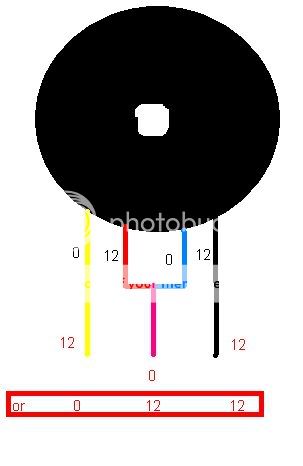After some advice, may be completely undoable but i thought id ask, if i had a transformer that had the sort of spec i required for a certain job but wasnt center tapped and i needed a center tap could i modify the transformer to have one? if so how would i go about it and if not please forgive me i apologize a thousand times 😀
Don't appologise for blowing yourself up, cos it aint happened............YET.
What is the transformer you have got. Single Tap, Dual Tap, Doolally Tap ?
What is the transformer you have got. Single Tap, Dual Tap, Doolally Tap ?
This is it, it mesures 12.8v AC across the yellow wires so i take it its a single secondry at 12v i need 12v 0v 12v, im grasping at straws i guess and should stop being cheap and buy one!


So you have 0-12. Would a center tap not give you 6-0-6 then?kanifee said:This is it, it mesures 12.8v AC across the yellow wires so i take it its a single secondry at 12v i need 12v 0v 12v
Especially in that power and price range.kanifee said:im grasping at straws i guess and should stop being cheap and buy one!



Centre-tapped transformer secondary
Not worth the trouble attempting to rewind that transformer. You want 12-0-12v? Get one with 2 independent secondaries of 12v. They will each be marked "0-12". Connect the "12" of the first winding to the "0" of the second, and there you have it. Visit the RS Components website to get an idea of the various types available.
Not worth the trouble attempting to rewind that transformer. You want 12-0-12v? Get one with 2 independent secondaries of 12v. They will each be marked "0-12". Connect the "12" of the first winding to the "0" of the second, and there you have it. Visit the RS Components website to get an idea of the various types available.
Your diagram is correct, but the text you have put in the red outlined box is NOT - that should read "0-12-24". Another way of looking at it would be to consider the 2 secy wdgs as two 1.5 batteries. Now imagine them connected in series, i.e. Neg terminal of Bat1 to Pos terminal of Bat2. If you were to put the COMM/Black lead of your meter on the joint and measure to the Pos of Bat1 you would see +1.5v. Leaving the COMM lead in the same place and then measuring to the Neg of Bat2 you would now see -1.5v. Measure from end to end and you would get 3v. It all comes down to polarity, combined with where your reference point is. Works with AC as well as DC! Hope this analogy helps.
Hmm ill have to have a read into it, i sort of understand the principle of the voltage but now im struggling to understand the output voltage of a given power supply.
The psu needs to run an 8v system, i was told to get a center tapped 12v-0-12v, i built a gainclone lm3886 with a 24-24 dual secondary transformer giving me 33.6v after rectification i think, so that same transformer center tapped would no longer be 0-24 0-24 but 0-24-48 if my understanding of what you said is correct, so if the value of the 12-0-12 is 24v or even 16.8v after rectification isn't that a little large, i know that its the correct transformer for the job as the person has vast amount of knowledge and this is a successful project im just not sure what it is im not grasping about the set up and the way it works.
Am i really missing the basics here, i know im a little challenging to learn but when it clicks it clicks properly lol believe me!
The psu needs to run an 8v system, i was told to get a center tapped 12v-0-12v, i built a gainclone lm3886 with a 24-24 dual secondary transformer giving me 33.6v after rectification i think, so that same transformer center tapped would no longer be 0-24 0-24 but 0-24-48 if my understanding of what you said is correct, so if the value of the 12-0-12 is 24v or even 16.8v after rectification isn't that a little large, i know that its the correct transformer for the job as the person has vast amount of knowledge and this is a successful project im just not sure what it is im not grasping about the set up and the way it works.
Am i really missing the basics here, i know im a little challenging to learn but when it clicks it clicks properly lol believe me!
Correct me if I am wrong, but isn't the transformer Kanifee has, got a single secondary winding?
If so then he only needs to remove windings from the secondary to get the voltage he requires.
Kanifee, if you are building a regulated supply, then you need a higher voltage than the one needed for your circuit. If not you should aim for the actual voltage. So to find out the secondary voltage of your transformer, divide the required DC voltage by 1.41.
If so then he only needs to remove windings from the secondary to get the voltage he requires.
Kanifee, if you are building a regulated supply, then you need a higher voltage than the one needed for your circuit. If not you should aim for the actual voltage. So to find out the secondary voltage of your transformer, divide the required DC voltage by 1.41.
If he needs 12-0-12. He can either buy a dedicated centre tapped tranny or a twin secondary 6v and join the two centre wires (Red & Orange) if he were using a Clairtronic (Rapid) tranny?:
http://www.clairtronic.com/toroidal.pdf
http://www.clairtronic.com/toroidal.pdf
You can use your existing transformer with a bridge rectifier to make your power supply, but without regulation it would produce about 17V.
dnsey said:You can use your existing transformer with a bridge rectifier to make your power supply, but without regulation it would produce about 17V.
Yes but that is a 0-17v supply, NOT a +/-17v supply!

Buy it then.kanifee said:i know that its the correct transformer for the job

Only?Nuuk said:he only needs to remove windings

Wouldn't that still be 6-0-6 then? 😉Puffin said:If he needs 12-0-12. He can either buy a dedicated centre tapped tranny or a twin secondary 6v and join the two centre wires
It will give about 17V with no load connected. At nominal load it will have something around 14V. Just the right range to get the best line regulation e. g. from 7808/7908 on all operating conditions.dnsey said:You can use your existing transformer with a bridge rectifier to make your power supply, but without regulation it would produce about 17V.
12Vac is a bit high for a regulated 8V supply.
It will make the regs run hot or maybe too hot when mains is up at max tolerance.
Try 9Vac or 10Vac for regulated 8Vdc
12Vac will usually allow regulated 11 to 12Vdc for all input and output variations.
It will make the regs run hot or maybe too hot when mains is up at max tolerance.
Try 9Vac or 10Vac for regulated 8Vdc
12Vac will usually allow regulated 11 to 12Vdc for all input and output variations.
converting 2x24 to 24-0-24
Hi, I had a question about wiring the secondaries of a toroidal transformer in series. I've been looking for a center tapped transformer for producing +/- 24 V, but it seems that a center tap with these specifications is hard to find from most common suppliers here in the us. It is easier to find a laminate transformer with a CT, but otherwise it seems rare in large sized toroidals, (from Digikey for instance). I've been doing some digging, and this post seems to be the most pertinent to the problem I'm having. I wanted to verify that the people recommending wiring the dual secondary coils in series have actually done so, and there aren't any caveats (like 'oh, we forgot to tell you, this will triple the load on the transformer, and it will explode'). The reason I ask is because this information seems to contradict the statements made here that it is ok:
http://www.newton.dep.anl.gov/askasci/eng99/eng99316.htm
and
http://www.mhennessy2.f9.co.uk/articles/power_supplies.htm
If you look at the last figure of mhennessy's article, it does indeed show dual rectification to produce a center tap. So which is correct? I'd prefer not to buy a transformer only to destroy it on first use. Additionally, are there any good US suppliers for a good and inexpensive CT toroidal transformer?
S
Hi, I had a question about wiring the secondaries of a toroidal transformer in series. I've been looking for a center tapped transformer for producing +/- 24 V, but it seems that a center tap with these specifications is hard to find from most common suppliers here in the us. It is easier to find a laminate transformer with a CT, but otherwise it seems rare in large sized toroidals, (from Digikey for instance). I've been doing some digging, and this post seems to be the most pertinent to the problem I'm having. I wanted to verify that the people recommending wiring the dual secondary coils in series have actually done so, and there aren't any caveats (like 'oh, we forgot to tell you, this will triple the load on the transformer, and it will explode'). The reason I ask is because this information seems to contradict the statements made here that it is ok:
http://www.newton.dep.anl.gov/askasci/eng99/eng99316.htm
and
http://www.mhennessy2.f9.co.uk/articles/power_supplies.htm
If you look at the last figure of mhennessy's article, it does indeed show dual rectification to produce a center tap. So which is correct? I'd prefer not to buy a transformer only to destroy it on first use. Additionally, are there any good US suppliers for a good and inexpensive CT toroidal transformer?
S
- Status
- Not open for further replies.
- Home
- Amplifiers
- Chip Amps
- messing with a transformer
